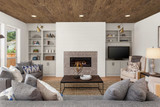
Pocket Friendly Woody Interior
This week, the Chicago Tribune posted an article about how you can add more warmth to your home's interior design when you "bring more of the great outdoors indoors" - and our faux wood wall paneling, and ceiling beams enable you to do that without breaking the bank.
"It makes people feel good when you bring in natural elements," says
Leigh Spicher, Director of Design Studios for Ashton Woods, in an interview in this week's Chicago Tribune. "Using wood on walls or the ceiling of a bathroom fits in with the trend toward using wood for trim and entire walls in all kinds of homes, from modern to traditional styles."
 Our Custom Driftwood Beams make a striking framework for this contemporary home.
Our Custom Driftwood Beams make a striking framework for this contemporary home.
I don't think any fans of design shows on HGTV or DIY Network would argue with that - as using natural materials like stone and wood seems not just to be 'in' at the moment, but also seems to be a design aesthetic that increasingly stands the test of time and resists looking dated.
"In a modern house, you can add rustic wood beams to the ceiling to add warmth and texture," says Jessica Parker, an interior designer and senior project manager with GTM Architects, in the same article. "We use wood consistently, especially in homes with an all-white kitchen or high ceilings. In a more traditional home, we install polished wood beams for a more refined look."
However, Leigh and Jessica are both talking about using wood in the context of new home builds - which gives them incredible flexibility and freedom to use different materials and also absorb the costs within the scope of the project costs. For many people looking to update their decor and give their home a fresh face, the idea of using real wood is both prohibitively expense and very impractical.
 The vivid texture of our Rough Hewn Beams makes for a striking ceiling accent.
The vivid texture of our Rough Hewn Beams makes for a striking ceiling accent.
This perhaps explains why the popularity of our faux wood products seems to be growing in parallel to the increased interest in wood-look and natural materials for the home. Our products offer a highly affordable alternative to real wood and timber; and yet don't require any compromise on looks.
This is because each of our line of products is created using molds taken from real wood and timber - from the deep gouges of our Custom Rough Hewn Beams to the aged perfection of our Rustic Ceiling Beams. The molding process captures every knot, grain and imperfection in vivid three-dimensional detail, which then allows us to recreate it perfectly in high-density polyurethane foam using an innovative injection-molding process.
Homeowners then have the option of staining the beams themselves, or ordering them in a variety of real-wood colors that are painstakingly detailed using a market-leading four-coat process. The result is a wood-look beam that is so realistic, it's impossible to tell from the real thing without reaching out and touching it.
But while they might look just as good - the design of our products provide a lot of benefits that using real wood and timber doesn't. This is especially true for people trying to add the customized look of real wood that Leigh and Jessica rave about to an existing home; and are limited by the scope of the existing architecture.
 The ability to conceal wiring from chandeliers and other fixtures provides a versatility that real wood can't match.
The ability to conceal wiring from chandeliers and other fixtures provides a versatility that real wood can't match.
Adding exposed wooden beams to a ceiling, for example, requires nothing more than mounting blocks drilled into the ceiling studs. Our faux beams are hollow inside, and simply slot over the mounting blocks to be secured with screws.
Likewise, our products can be used to conceal wires, cables and ducting in a manner that's simply impossible to do with real wood - and can be used to conceal recessed lighting, mask ceiling fixtures like fans or chandeliers, or even seamlessly incorporate LED lights or hidden speakers.
This versatility, combined with the extremely low cost of 'going faux' in comparison to using real wood, means you can reap all the benefits that the Chicago Tribune article raves about; without breaking the bank.
"Wood is a great way to personalize a space, to give it character and texture," the article says. "Wood adds a lot of warmth and is welcoming when you make the transition from the exterior to the contemporary interior."
The article ends talking about the disadvantages of using real wood.
"Adding a wood ceiling to a room can cost $5,000 to $10,000," Jim Rill, owner of Rill Architects, is quoted as saying.
Our products cost just a fraction of that - without any compromise on looks or style.
"If you're installing wood in a damp room such as a bathroom, pressure-treated poplar is a good choice, because it's more resistant to mold," Leigh Spicher says. "It's also smart to install a backsplash between the sink and wood to protect the wood from getting too wet."
Again, these are issues that our faux products don't have - because they are made from a closed-cell polymer that is water-resistant and impervious to warping, cracking, mold and rot.
These examples just demonstrate how you can get the look of a modern, custom-built home without compromising cost or look - and the other advantages speak for themselves.
Shop Related Products


